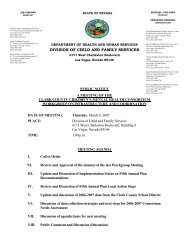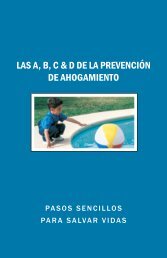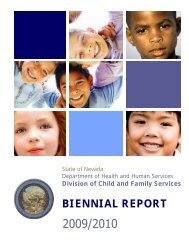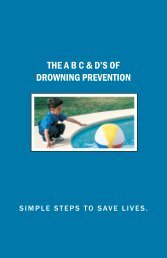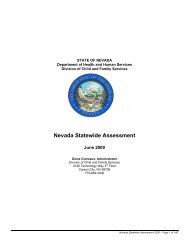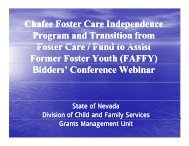STATE OF NEVADA - Division of Child and Family Services
STATE OF NEVADA - Division of Child and Family Services
STATE OF NEVADA - Division of Child and Family Services
Create successful ePaper yourself
Turn your PDF publications into a flip-book with our unique Google optimized e-Paper software.
Overall the DR program has been well implemented with good effect, providing services to a set <strong>of</strong> families that have<br />
previously not received them. At the same time, a relatively small percentage <strong>of</strong> all child maltreatment reports are<br />
referred to FRC’s for a DR family assessment, so that the impact on the broad CPS system in the state is limited.<br />
Juvenile Justice: A third example <strong>of</strong> collaboration in the Nevada child welfare system is with juvenile justice. Following<br />
a federal compliance review in July 2006, it was found by the <strong>Child</strong>ren’s Bureau <strong>of</strong> the Administration on <strong>Child</strong>ren <strong>and</strong><br />
Families (ACF) that the <strong>Division</strong> failed to include in the Adoption <strong>and</strong> Foster Care Analysis <strong>and</strong> Reporting System (also<br />
known as AFCARS) report, youth that receive juvenile justice services while under the agency’s responsibility for care <strong>and</strong><br />
placement. All children in foster care under the responsibility <strong>of</strong> the State agency administering or supervising the<br />
administration <strong>of</strong> the Title IV-B <strong>Child</strong> <strong>and</strong> <strong>Family</strong> <strong>Services</strong> State plan <strong>and</strong> the Title IV-E State plan; that is, all children who<br />
are required to be provided the assurances <strong>of</strong> section 422(b)(10) <strong>of</strong> the Social Security Act (the Act) (Appendix A –<br />
SECTION II). In Nevada, the juvenile correctional facilities <strong>and</strong> youth parole fall under these requirements. Because the<br />
youth served in this population are a part <strong>of</strong> the IV-E agency, the <strong>Division</strong> has made efforts to ensure that youth in out <strong>of</strong><br />
home unlocked facilities are afforded the same IV-E assurances as youth in the custody <strong>of</strong> the child welfare agency.<br />
During this year, the <strong>Division</strong> hired a Program Specialist specifically to focus on developing policy, procedure <strong>and</strong> training<br />
for staff on how to work with these youth. The program specialist has been focusing on developing training guides related<br />
to SACWIS system requirements, developing policy <strong>and</strong> procedure on required casework activities, <strong>and</strong> will be assisting<br />
the Youth Parole Bureau with ensuring that engagement <strong>and</strong> casework strategies are effectively implemented. This<br />
position will also focus on training staff <strong>and</strong> ensuring Fostering Connections m<strong>and</strong>ates for older <strong>and</strong> aging out youth are<br />
met. Table 42 includes the number <strong>of</strong> children that were transferred to juvenile custody (probation/incarceration) from<br />
child welfare (receiving services or in protective custody). These youth were known to the child welfare system prior to<br />
entering the juvenile justice system <strong>and</strong> these numbers are collected on a monthly basis via UNITY.<br />
Table 42: <strong>Child</strong>ren Transferred into Custody from the Juvenile Justice System SFY 2010<br />
Age Male Female Total # Committed<br />
13 0 0 0<br />
14 0 0 0<br />
15 2 1 3<br />
16 2 1 3<br />
17 6 2 8<br />
18 7 3 10<br />
Total 17 7 24<br />
Nevada Tribal Community: The State continues to consult with the 27 Nevada federally-recognized tribes, b<strong>and</strong>s <strong>and</strong><br />
organizations (Section 422(b) (11), Social Security Act, as amended) through the Indian <strong>Child</strong> Welfare Committee <strong>and</strong> the<br />
Inter-Tribal Council <strong>of</strong> Nevada (ITC-N). The Indian <strong>Child</strong> Welfare Committee invites Tribal Chairs, or their designee(s), to<br />
participate on the committee for the purpose <strong>of</strong> discussing Indian child welfare issues in Nevada that relate to jurisdiction,<br />
investigation, <strong>and</strong> service delivery. Members <strong>of</strong> the Indian <strong>Child</strong> Welfare Committee include: representatives from the<br />
ITC-N, which is comprised <strong>of</strong> 27 Nevada Tribal Chairs/Vice-Chairs <strong>and</strong> Council Members or designees; members <strong>of</strong> Tribal<br />
Human Social <strong>Services</strong> agencies; Bureau <strong>of</strong> Indian Affairs; Nevada Urban Indians, Inc., Las Vegas Indian Center; Nevada<br />
Indian Commission; Nevada <strong>Child</strong>ren’s Justice Act ; DCFS Rural Region, CCDFS Department <strong>of</strong> <strong>Family</strong> <strong>Services</strong> <strong>and</strong><br />
WCDSS Department <strong>of</strong> Social <strong>Services</strong>; the UNR Partnership for Training, <strong>and</strong> other interested parties. The following<br />
presentations <strong>and</strong> consultations occurred during this report period:<br />
Indian <strong>Child</strong> Welfare Committee:<br />
On June 9, 2009; the Technical Assistance to Local Communities <strong>and</strong> Indian Tribes (TALCIT) Committee met with the<br />
CJA Task Force <strong>and</strong> presented a request to combine TALCIT <strong>and</strong> the ICWA Steering Committee into one CJA Task<br />
Force committee called the Indian <strong>Child</strong> Welfare Subcommittee. Both committees were working on the same projects, so<br />
efficiency would be improved by joining the two groups. The CJA Task Force approved the formation <strong>of</strong> the new single<br />
committee. Subsequently, the committee worked throughout the remainder <strong>of</strong> 2009 to plan an ICWA training track as part<br />
<strong>of</strong> Nevada’s Inter-Tribal Council <strong>of</strong> Nevada (ITC-N) annual convention, which was held in November 2009. A primary<br />
focus <strong>of</strong> the ICWA training track was to educate Nevada tribes about changes in federal law for tribal access to Title IV-E<br />
funding<br />
Nevada APSR – SFY 2010<br />
Page 77 <strong>of</strong> 108



